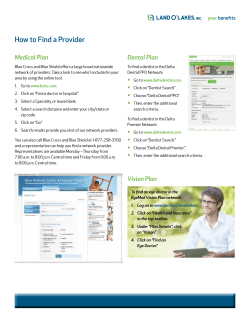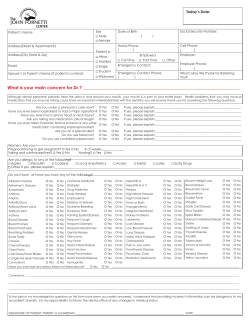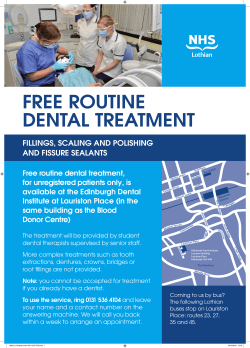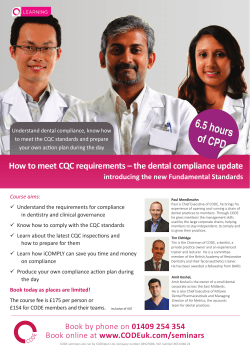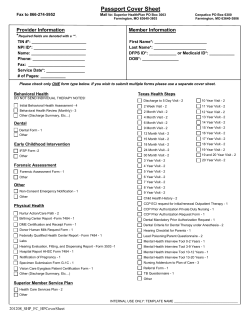
EU Manual of Dental Practice 2014 Edition 5
EU Manual of Dental Practice 2014 Edition 5 __ ____________________________ Council of European Dentists MANUAL OF DENTAL PRACTICE 2014 Estonia ***** Authors: Dr Anthony S Kravitz OBE and Professor Alison Bullock Professor Jon Cowpe with Ms Emma Barnes Cardiff University, Wales, United Kingdom © The Council of European Dentists February 2014 1 EU Manual of Dental Practice 2014 Edition 5 ________________________________________________________ ________ __ The revised EU Manual of Dental Practice (Edition 5) was commissioned by the Council of European Dentists1 in April 2013. The work has been undertaken by Cardiff University, Wales, United Kingdom. Although the unit had editorial control over the content, most of the changes were suggested and validated by the member associations of the Council. About the authors2 Dr Anthony Kravitz graduated in dentistry from the University of Manchester, England, in 1966. Following a short period working in a hospital he has worked in general dental practice ever since. From 1988 to 1994 he chaired the British Dental Association’s Dental Auxiliaries’ Committee and from 1997 until 2003, was the chief negotiator for the UK’s NHS general practitioners, when head of the relevant BDA committee. From 1996 until 2003 he was chairman of the Ethics and Quality Assurance Working Group of the then EU Dental Liaison Committee. He gained a Master’s degree from the University of Wales in 2005 and subsequently was awarded Fellowships at both the Faculty of General Dental Practice and the Faculty of Dental Surgery, at the Royal College of Surgeons of England. He is an Honorary Research Fellow at the Cardiff University, Wales and his research interests include healthcare systems and the use of dental auxiliaries. He is also co-chair of the General Dental Council’s disciplinary body, the Fitness to Practise Panel. Anthony was co-author (with Professor Elizabeth Treasure) of the third and fourth editions of the EU Manual of Dental Practice (2004 and 2009) President of the BDA from May 2004 until May 2005, he was awarded an honour (OBE) by Her Majesty The Queen in 2002. Professor Alison Bullock: After gaining a PhD in 1988, Alison taught for a year before taking up a research post at the School of Education, University of Birmingham in 1990. She was promoted to Reader in Medical and Dental Education in 2005 and served as coDirector of Research for three years from October 2005. She took up her current post as Professor and Director of the Cardiff Unit for Research and Evaluation in Medical and Dental Education (CUREMeDE) at Cardiff University in 2009. With a focus on the education and development of health professionals, her research interests include: knowledge transfer and exchange; continuing professional development and impact on practice; workplace based learning. She was President of the Education Research Group of the International Association of Dental Research (IADR) 2010-12. Professor Jonathan Cowpe graduated in dentistry from the University of Manchester in 1975. Following training in Oral Surgery he was appointed Senior Lecturer/Consultant in Oral Surgery at Dundee Dental School in 1985. He gained his PhD, on the application of quantitative cyto-pathological techniques to the early diagnosis of oral malignancy, in 1984. He was appointed Senior Lecturer at the University of Wales College of Medicine in 1992 and then to the Chair in Oral Surgery at Bristol Dental School in 1996. He was Head of Bristol Dental School from 2001 to 20004. He was Dean of the Faculty of Dental Surgery at the Royal College of Surgeons in Edinburgh from 2005 to 2008 and is Chair of the Joint Committee for Postgraduate Training in Dentistry (JCPTD). He has been Director of Dental Postgraduate Education in Wales since 2009. His particular interest now lies in the field of dental education. He was Co-ordinator for an EU six partner, 2-year project, DentCPD, providing a dental CPD inventory, including core topics, CPD delivery guidelines, an e-learning module and guidelines (2010-12). Ms Emma Barnes: After completing a degree in psychology and sociology, Emma taught psychology and research methods for health and social care vocational courses, and later, to first year undergraduates. Following her MSc in Qualitative Research Methods she started her research career as a Research Assistant in the Graduate School of Education at the University of Bristol, before moving to Cardiff University in 2006, working firstly in the Department of Child Health and then the Department of Psychological Medicine and Clinical Neurosciences. In 2010 Emma joined Cardiff Unit for Research and Evaluation in Medical and Dental Education (CUREMeDE) as a Research Associate. Working in close collaboration with the Wales Deanery, (School of Postgraduate Medical and Dental Education), her work focuses on topics around continuing professional development for medical and dental health professionals, and knowledge transfer and exchange. 1 2 2 CED Brussels Office, Avenue de la Renaissance 1, B - 1000 Brussels, Tel: +32 - 2 736 34 29, Fax: +32 - 2 732 54 07 The authors may be contacted at AnthonyKravitz@gmail.com ____________________________ EU Manual of Dental Practice 2014 Edition 5 __ Estonia In the EU/EEA since Population (2013) GDP PPP per capita (2012) Currency Main language Estonia 2004 1,324,814 €16,720 Euro Estonian (65%) Russian (28%) Healthcare is funded through general taxation, with an additional special tax for health, which is paid by employer at 13% of salaries. Much is also funded by patients as 96% is private. Number of dentists: 1,615 Population to (active) dentist ratio: 1,208 Members of Estonian Dental Association: 50% There are three specialisms – oral maxillo-facial surgery, orthodontics and clinical dentistry. The use of auxiliaries is limited to a few hygienists. Continuing education is not mandatory, but there is a general requirement to keep skills updated. Date of last revision: 30th January 2014 Government and healthcare in Estonia The Republic of Estonia, Eesti Vabariik in Estonian, lies on the eastern shores of the Baltic Sea. The name Eesti is apparently derived from the word Aisti, the name given by the ancient Germans to the people living northeast of Visla. Estonia is situated on the level north-western part of the East-European platform, on which there are only slight variations in elevation. The average elevation is only about 50m and the highest point (Suur Munamägi) is only 318m above sea level. With the Gulf of Finland in the north, and the Baltic Sea in the west, Estonia shares land borders with Russia to the east and Latvia to the south. Estonia comprises an area of 45,215 sq. km., making it larger than, for instance Denmark, Switzerland, the Netherlands, Belgium and Albania in Europe. The capital, Tallinn, is on the Northern shore. In 1991 Estonia gained its independence as a state. The new Constitution of 1992 established the principles of the State, setting Estonia as a democratic parliamentary republic – with a President, Prime Minister and Cabinet and a State assembly known as the Riigikogu. Elections to the Riigikogu take place every 4 years. Local governments, separated from the central power, are based on 15 counties. Since 1989, the population in Estonia has been dropping, by 21% between 1990 and 2013, due to emigration and negative natural growth. Healthcare delivery in Estonia is provided through private practice and a statutory health insurance system (Sick Funds). The membership of the system is appointed by the Parliament. Local governments can also provide support. The source of income of the health insurance is 13% of the social tax or 13% of the employee’s gross salary paid by the employer. Health insurance is based on the solidarity principle: health service is not dependent on the amount of social tax paid for the specific person. The health insurance fund pays the cost of health services to the medical institution for the insured person. In Estonia all persons are entitled to receive emergency care regardless of having health insurance or not. On 1 January 2010, three Estonian governmental health authorities (i.e. the Health Protection Inspectorate, the Health Care Board and the Chemicals Notification Centre) were united into one joint Health Board. The Health Board is a government agency within the Ministry of Social Affairs. Its main fields of activity are: medical devices; healthcare; communicable diseases and control; environmental health; chemical safety. Total health expenditure in 2011 was €944.6M, an increase of 4% over 2010. Public health expenditure was 4.7% of GDP, so private expenditure was 1.3% of GDP. In other words, about 80% of health expenditure was public and about 20% private. % GDP spent on health % of this spent by government Year Source 6.0% 2011 OECD 78.3% 2011 OECD 3 EU Manual of Dental Practice 2014 Edition 5 ________________________________________________________ Oral healthcare % of GDP spent on oral health % of OH expenditure private Year Source 0.30% 2011 Ministry 66% 2006 Ministry “Ministry” refers to the Ministry for Social Affairs It has not proved possible to obtain meaningful up to date figures for what percentage of the total expenditure on oral health is paid for by patients directly (ie private) and what percentage is paid for by government (ie public). The Estonian Dental Association has reported that the public proportion is reducing. Public dental care Almost all adult oral healthcare in Estonia is provided through general (private) practice. Dental care services for adult patients (over 19) are paid by patients and reimbursed by the sick fund although emergency care (traumas, infections) is actually paid by the sick fund, but only for those who are members of it. Patients who do not have insurance can have only first aid. Since October 1st 2002 the Sick Funds have provided this limited financial support for oral healthcare. Treatment is provided and is free for children under 19 years of age, provided they visit a dentist with a contract with the Sick Fund. Other patients do not receive reimbursement exept pensioners – in 2013, €19 for a checkup and €255 for prosthetic work once during a 3-year period.. Orthodontic treatment is free to children under 19 years - with severe malocclusion - with all kinds of appliances Pregnant women, or nursing mothers whose child is less than one year of age, can receive reimbursement of up to €28.76. Oral examinations would normally be undertaken every 6 to 12 months, more frequently for patients with periodontal conditions. There is no prior approval system for treatment. The Estonian Dental Association reports that they believe that most 4 ________ __ of the population visit a dentist within any 2-year period. This is what dentists ask from patients. In some private clinics dentists give a guarantee for the technicians work only if the patient visits the dentist every 6 months for two years. Access to oral healthcare may be difficult for patients who live in some urban areas, as well as all those in rural areas, as salaries there are generally too low for what is almost private care, with the low reimbursements. Indeed, there may be difficulties for patients, all over Estonia, obtaining prosthetic treatment under the scheme. Private dental care As stated previously, most adult dental treatment is provided under fully (liberal) private contract between patients and their dentists. There is no regulation of private fees and there are no dental insurance schemes in Estonia. The Quality of Care There are no routine quality checks, so the system relies on a complaint from a patient, for monitoring purposes. Health data Year Source DMFT at age 12 2.40 2012 OECD DMFT zero at age 12 25% 2003 OECD Edentulous at age 65 No data “DMFT zero at age 12” refers to the number of 12 years old children with a zero DMFT. “Edentulous at age 65” refers to the numbers of over 64s with no natural teeth Fluoridation There are no specific community fluoridation schemes in Estonia. Undergraduate Training To enter dental school a student has to have completed secondary school (usually at the age of 18). There is an entrance examination. Estonia ____________________________ Education, Training and Registration EU Manual of Dental Practice 2014 Edition 5 _ country. The register is administered by the Healthcare Board/General Dental Council, within the Commission for Licence (the competent authority). There is full information available at: http://www.tervishoiuamet.ee/index.php?page=158 Language requirements Year of data: 2013 Number of schools 1 Student intake 32 Number of graduates 30 Percentage female 87% Length of course 5 yrs Until 2003 the student intake was higher (40). The dental school is situated within the Faculty of Medicine in the University of Tartu. It is publicly funded. The dental course has been “EU-compliant” for some years, so most Estonian graduates have been able to work elsewhere in the EU from May 1st 2004. Quality assurance for the dental school is provided by the Ministry of Education and Social Affairs. Qualification and Vocational Training Primary dental qualification The primary degree which may be included in the register is “DDS Dentist”. Vocational Training (VT) There is no vocational training for dentists in Estonia. Registration Cost of registration (2013) € 13 To register in Estonia, a dentist must have a recognised degree or diploma awarded by the university, or from another EU There are no formal linguistic tests in order to register, although dentists from outside the EU are expected to speak and understand Estonian. Further Postgraduate and Specialist Training Continuing education Continuing education is not mandatory, but under Estonian legislation there is a general requirement to keep skills updated. Postgraduate education is delivered through the Tartu University Postgraduate Training Centre and the Estonian Dental Association. Specialist Training There is training in 3 specialties: Orthodontics Oral Maxillofacial Surgery Clinical Dentistry Specialists train in the University. There is no minimum of years pre-training (working as a dentist after basic education), before entering specialist training. Training lasts for 3 years for Orthodontics and Clinical Dentistry and 5 years for Oral Maxillofacial Surgery. All postgraduates must pass a university examination. The specialist education and training leads to a degree, “Specialist in Orthodontics”, “Maxillofacial Surgeon” or “Specialist in Clinical Dentistry”. Specialists in Clinical Dentistry undertake training in endodontics, periodontics and prosthodontics. Only orthodontics is recognised by the Healthcare Board/General Dental Council and registered as a specialty, in addition to Oral Maxillo-facial surgery, which officially is a dental specialty under a law introduced in 2002. Specialists in Restorative (Clinical) Dentistry were recognised from 2004, and need to be registered as such. 5 EU Manual of Dental Practice 2014 Edition 5 _________________________________________ Workforce Dentists Hygienists Year of data: 2013 Total Registered 1,615 In active practice 1,250 Dentist to population ratio* 1,358 In 2012, it was reported that there were 2 hygienists in Estonia, who had been trained outside the country, and 32 who had trained in Estonia. They are permitted to work under the supervision of a dentist. * active dentists only The 32 hygienists are not registered because their education is thought to be too short and there is no such dental auxiliary specified as “hygienist”. However, in 2013 work was being done by the dental association to recommend a professional standard for them, so that in the near future they can be formally recognised. The majority of dentists are self-employed and there is no reported unemployment amongst dentists in Estonia. All hygienists are salaried. The Insurance Fund does not pay for their service. Percentage female 87% Qualified overseas 4 Some dentists practise in more than one sphere of practice. Movement of dentists across borders There is only small movement of overseas dentists into Estonia and little outwards. Specialists Specialists work mainly in private practice and patients access them by referral from other dentists. Dental Technicians The title is legally protected and there is a registerable qualification which dental technicians must obtain before they can practice. They train in the country’s special technicians’ school, for a period of 3.5 years. The register is held by the Healthcare Board. Their duties are to prepare dental prosthetic and orthodontic appliances to the prescription of a dentist and they may not work independently, except for the provision of repairs to prostheses. Year of data: 2013 Orthodontics 62 Individual technicians are normally salaried and work in commercial laboratories which bill the dentist for work done. 19 There is no reported illegal activity. Paedodontics Clinical dentistry includes Periodontics, Dental Nurses Prosthodontics & Endo Oral Surgery Dental Public Health OMFS 25 The system of use of dental auxiliaries is developing in Estonia. Year of data: Hygienists Technicians 2013 32 137 Denturists 0 Assistants 1,540 Therapists Nurses follow 3.5 years training of Medical Nurse, and then are trained in dentistry by the dentist, with institutional support. They receive a diploma, which they must register with the Healthcare Board. Their duties are to assist the dentist, including the cross infection control. They are paid by salary by their employers. Auxiliaries 6 ___________________ ____ __ 0 Dental Therapists In earlier years it was reported that there were dental therapists in Estonia (26 in 2008), but by 2013, none were practising. Estonia ____________________________ Practice in Estonia EU Manual of Dental Practice 2014 Edition 5 _ Working in Public Dental Service Year of data: 2013 General (private) practice 1,200 Public dental service University 18 Hospital 35 Armed Forces General Practice as a proportion is 5 96% Public Dentistry ceased to exist from the beginning of 2004. The last dental clinic was privatised. Local government can partly own clinics or support them financially Working in Hospitals Hospitals in Estonia are all public foundations. All the hospital dentists are Oral maxillo-facial surgeons who work as salaried employees. They undertake mostly surgical treatments. Dentists who practice on their own, or as small groups, outside hospitals or health centres, and who provide a broad range of general treatments are said to be in private practice. Many only work part-time in private practice. Some private dentists provide some publicly funded or assisted oral healthcare, mainly for children. There are generally no restrictions on these dentists seeing other patients outside the hospital, in private practice. The quality of dental care is assured through dentists working in teams under the direction of experienced specialists. The complaints procedures are the same as those for dentists working in other settings. About 90% of private practitioners work in single dentist practices. Working in Universities and Dental Faculties Most dentists in private practice are self-employed and earn their living through charging fees for treatments. The patient pays the dentist in full and some then reclaims a partial or full reimbursement from the local office of the sick fund. Fee scales Since September 1998, there has been a partnership for the negotiations on fee scales between the Sick Fund Price Commission and the Estonian Dental Association. Joining or establishing a practice There are no rules which limit where a practice may open, but this has led to problems, as most dentists want to work in either Tallinn or Tartu, where the dentist to population ratio has fallen to 1:750. The opening of a practice is subject to the approval by the local health department. Existing practices are also bought and sold on the open market. Practices can be found in all types of accommodation. Within practices, there is a minimum limit to the size of rooms and the facilities supplied. The state offers no assistance for establishing a new practice, and generally dentists must take out commercial loans from a bank. There are no rules relating to the numbers of dentists or partners in the practice. Dentists who work in the dental school are salaried employees of the university. About half work part-time - they are allowed to combine their work in the faculty with part-time employment in private practice, elsewhere. The senior academic title within the Estonian dental faculty is that of university professor, who since 2002 must be DDS. Other titles include docents and teachers. There are no formal requirements for postgraduate training but docents and professors will have completed a PhD, and most will also have received a specialist clinical training. To be elected to the post of professor a dentist must have published scientific research of at least 3 dissertations. Apart from these there are no other regulations or restrictions on promotion. The quality of clinical care, teaching and research in the dental faculty is assured through the old traditions of Tartu University (formed in 1632) and a Ministry of Education curriculum which has been accredited by the international commission 2002, following a DentEd visit in 2001. Any epidemiological studies are local – being undertaken by enthusiastic teachers only. Working in the Armed Forces There are around 5 dentists working full time for the Armed Forces. 7 EU Manual of Dental Practice 2014 Edition 5 _________________________________________ Professional Matters ___________________ ____ __ Professional Associations patient or the doctor/dentist may complain to the Court. There is one professional association, the Estonian Dental Association (EDA) - Eesti Hambaarstide Liit. Data Protection Number Estonian Dental Association Year 799 2012 Source FDI The Association represents private and public health dentists and combines this role by trying to emphasise common, professional matters. The EDA represents Estonia at international meetings. The EDA is run by a Board, secretary and 40 (elected) council members. It is established to protect dentists as liberal professionals, and represent members in negotiations with local authorities, ministries and legal bodies. It provides members information about changes in legislation and offers advice to dentists on legal affairs. Together with the Society, the EDA arranges lectures and conferences. The ESS was first founded in 1921. Annual dental meetings are organised by the ESS. There is also an Estonian Dentistry Students Association. Estonia has a Data Protection Law and all dentists who apply for the permission to work, have to first have permission from the Data Protection Service. The EU Directive has been adopted by Estonia. Advertising Advertising is permitted, provided that it is legal, decent, honest and fair – and may take place in any of the mediums such as TV, radio and the press. However, comparison of skills with another dentist is not permitted. Dentists are allowed to promote their practices through websites subject to the usual rules of “legal, decent, honest and fair”, but they are required to respect the legislation on Electronic Commerce, and the data protection law. Insurance and professional indemnity Estonian dentists have a “Responsibility Insurance”, but this is voluntary. Corporate Dentistry Ethics and Regulation Ethical Code Dentists are subject to an ethical code which is based on the Council of European Dentists’ Ethical Code. Supervision of this is by the Estonian Dental Association. However, the Ethical Code is not mandatory, it is only recommended, so dentists may receive only a written warning, on non-compliance, or removal as a member of the Association. Fitness to Practise/Disciplinary Matters If this is unsatisfactory for patients then they may make a claim to the Consumer Protection Bureau. For disciplinary purposes a complaint by a patient is investigated by a “Treatment Quality Commission”, which is appointed by the Ministry of Social Affairs, Health Department’s Supervision Department. Patients may also write an application to the Consumer Protection Service, but they send their complaint to the Health Department’s Supervision Department first. In the Treatment Quality Commission there is one dentist, who is appointed by the Ministry of Social Affairs Health Department, as a dental councillor. A patient will be examined, if it is necessary, by a commission appointed by the dental councillor. If it is reported to the Treatment Quality Commission that quality is below standard, then they may call to order the dentist and demand that he undertakes and passes courses, or they may suspend temporarily the working permit, until the reported deficiency is removed. The Dental Councillor is a member of the board of the Estonian Dental Association. For appeals against what they consider an adverse decision the 8 Dentists are allowed to form “limited companies” and nondentists may be part or full owners of such companies. Tooth whitening Tooth whitening comes under Cosmetic legislation if the hydrogen peroxide is up to 5.5%..Only dentists may use this on patients. In 2013 there was some illegal practice but the Health Board was focussed on stopping this. Health and Safety at Work Hepatitis B vaccinations for dentists and their staff are not mandatory, and the practice owner must pay for any voluntary inoculations undertaken. Ionising Radiation There are specific regulations relating to radio protection. Training is mandatory for undergraduate dentists and then they become the competent person to direct radiation. They must undertake continuing education every five years. The Radiation Protection Centre registers and controls radiation equipment. Hazardous waste Amalgam separators are not required by law, although they are advised. ____________________________ Estonia EU Manual of Dental Practice 2014 Edition 5 __ Regulations for Health and Safety For Administered by Ionising radiation Radiation Protection Centre Electrical installations Health Protection Bureau Infection control Health Protection Bureau Medical devices Heath Protection Service Waste disposal Health Protection Bureau Financial Matters Retirement pensions and healthcare State pensions are financed by a social tax paid by all employers on behalf of their employees and by the selfemployed. The rate of social tax is 33% of the gross payroll. The share of social tax allocated for pensions is 20% of the gross payroll (13% is allocated for health insurance). The state pension is based on the principle of redistribution, ie the social tax paid by today’s employees covers the pensions of today’s pensioners. Men have the right to old age pension at the age of 63 and women at the age of 60.5. The pension age for men and women will be equal by 2016 with the women's qualifying age gradually rising to 63. People working after reaching the pension age are entitled to a full pension, regardless of their work income. The pension can be up to €336 a month. Liberal dental practitioners may work until any age. There are two supplementary schemes. To encourage participation in the supplementary pension schemes, there are tax incentives. Taxes National income tax: The rate of income tax is a flat rate of 21% (2013). VAT/sales tax The standard VAT rate is 20%. A reduced rate of 9% is available on such items as books, newspapers, medicines and accommodation. Medical and dental services are not included in VAT. Various Financial Comparators Tallin Zurich = 100 2003 2012 Prices (including rent) 46.1 48.9 Wage levels (net) 11.9 21.4 Domestic Purchasing Power at PPP 15.6 37.0 Source: UBS August 2003 & November 2012 9 EU Manual of Dental Practice 2014 Edition 5 _________________________________________ Other Useful Information ___________________ ____ __ Dental associations and information centres: Estonian Dental Association: 1) Narva mnt 5-76 10117 Tallinn ESTONIA Tel: +372 64 59 001 Fax: +372 64 59 001 Estonian Dentistry Students Association Raekoja plats 6 50013 Tartu ESTONIA Office: Nooruse 7-901 50408 Tartu ESTONIA Tel: +372 7 381 241 Fax: Email: info@ehyl.ee Website: www.ehyl.ee 2) Lille 12-5 51003 Tartu ESTONIA Tel: +372 7319 855 Fax: +372 7428 608 Email: tallinn@ehl.ee Website: www.ehl.ee Competent authorities: Health Board Gonsiori 29 Tallinn 15157 Estonia Tel: +372 650 9840 Fax: +372 650 9844 Email: info@terviseamet.ee Website: www.terviseamet.ee 10 Tartu Dental school: The General Dental Council 29 Gonsiori Str, Tallinn 15157 Estonia Tel: +372 6509840 Fax: +372 6509844 Email: info@tervisemet.ee Website: www.terviseamet.ee The Dean Prof.Mare Saag Clinic of Stomatology, Tartu University Raekoja Platz 6 51003 Tartu ESTONIA Tel: +372 7319 855 Fax: +372 7428 608 Email: mare.saag@kliinikum.ee Website: http://www.med.ut.ee/stom
© Copyright 2025


